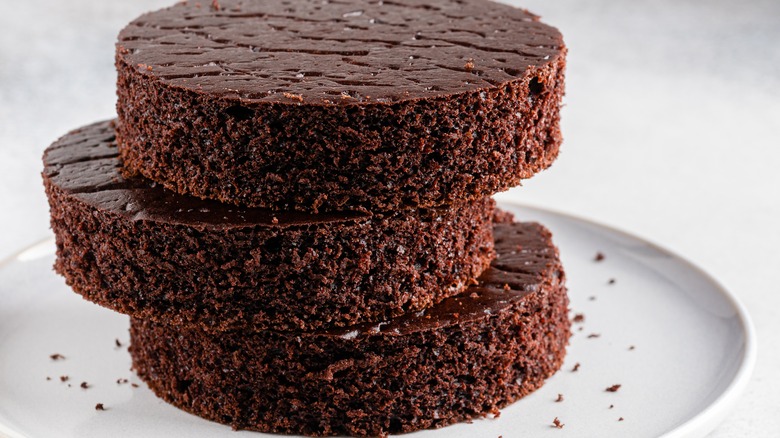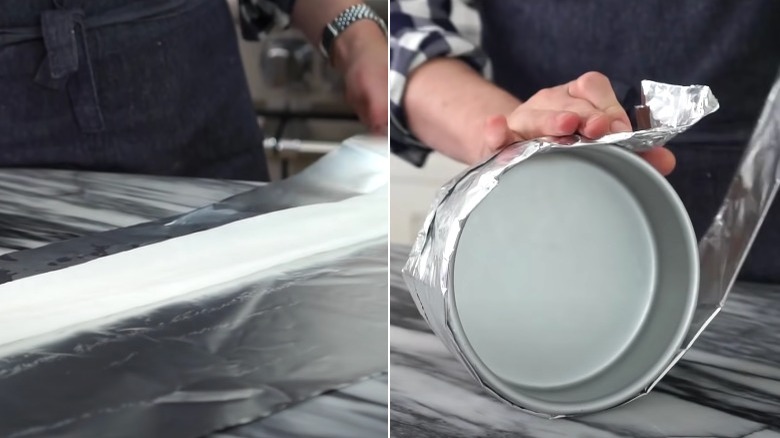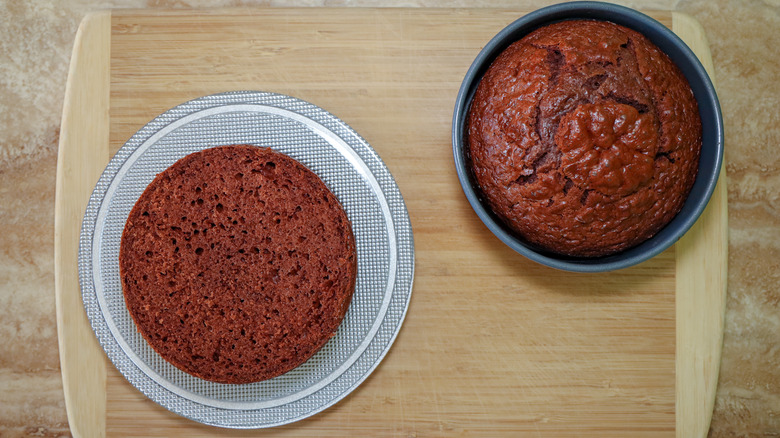The Damp Towel Trick To Ensure Even Cake Layers
This is a "good news, bad news" situation: the good news is that we have a baking tip that will prevent cake layers from doming, creating perfectly even cakes directly out of the oven, but the bad news is that this technique eliminates snacking on the trimmed-off cake scraps.
Of all the things that can go wrong in baking, cake doming is probably the most common and accepted natural consequence, but it doesn't need to be. Bakers can use commercial cake strips or wrap the pans in damp towels to lower their temperature and stop this from happening. This solution is so simple that it sounds like it wouldn't really work, but it insulates the pan's sides, slowing the process, and allowing the edges more time to rise, creating flat, even layers.
Without towels or cake strips, doming occurs because the edges of the cake cook faster than the center. As the batter heats, the butter, eggs, and commercial leaveners release air or carbon dioxide, causing the cake to rise. Once the batter hits 155-180 degrees Fahrenheit, it sets (or stops rising).
Since cakes cook from the exterior inward, the batter touching the pan's sides gets hotter than the one in the middle (which is insulated by the surrounding batter). This causes the edges to set before the center, creating a dome and overcooked sides. This is why we test the cake's doneness by inserting a toothpick in the center of the cake, not the edge.
How to make cake strips
If you don't feel comfortable putting your towels in the oven, you can buy cake strips or make your own. The advantage of buying them is that they are often adjustable to accommodate different shapes and sizes and are heat-safe up to 400 degrees Fahrenheit. Brands like Wilton offer products such as Bake-Even Cake Strips, which are available for under $10 for a package of two, but they can be made at home for free with the same outcome.
As demonstrated by cooking and baking expert John Kanell on YouTube, measure a paper towel or strip of fabric long enough to fit around the circumference of your cake pan. You will need a piece roughly 25 inches long for an eight-inch pan and 29 inches for a 9-inch pan. Soak the towels in water, wring out the excess, and lay the damp towel flat on the countertop. Be careful if using paper towels since they tear easily when wet.
Cut a piece of aluminum foil 3 inches longer than the towel and lay it on the countertop. Fold the damp towel lengthwise to match the depth of the cake pan (most are 2 to 3 inches), then place it in the center of the foil. Fold the foil around the towel, creating a long insulated strip, and mold it to the outside of the pan. Crimp the edges together to hold it in place. The aluminum foil will keep the moisture in as the cakes gently bake.
What else can cause cake doming?
Once baked, the cake layers should be level, although slight crowning is natural. If they are not, the oven may be too hot. Make sure you thoroughly preheat it before baking and check to see if it's actually the temperature it registers. An inexpensive oven thermometer is helpful and will confirm whether the oven needs to be recalibrated. Sometimes, turning it down ten degrees will do the trick.
If the oven is accurate, then the recipe may be to blame. Too many leavening agents like baking powder or baking soda can cause the cake to rise too much. Although each recipe differs, one cup of flour should have roughly 1 teaspoon of baking powder or ¼ of a teaspoon of baking soda. If the ingredients deviate significantly from this guide, not only could the cake rise too much, creating an excessive dome, but it could also develop a chemical taste, so it may be time for a different chocolate cake recipe.
Some dome trimming is inevitable to prevent the top layer from tragically sliding off, especially for multi-layer cakes. To make an accurate cut, place toothpicks around the cake's circumference as a guide and use a serrated knife to trim it, or invest in a commercial cake leveler.



